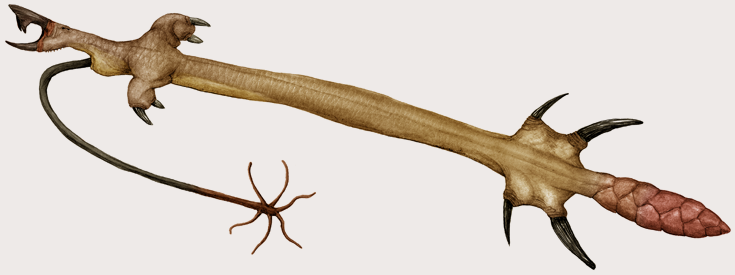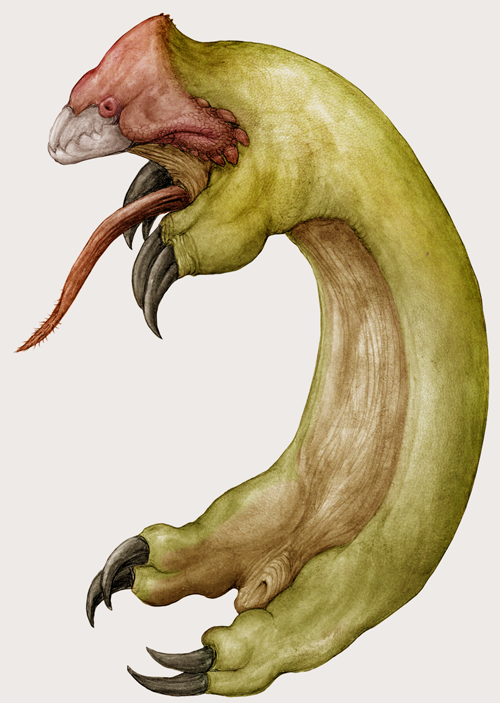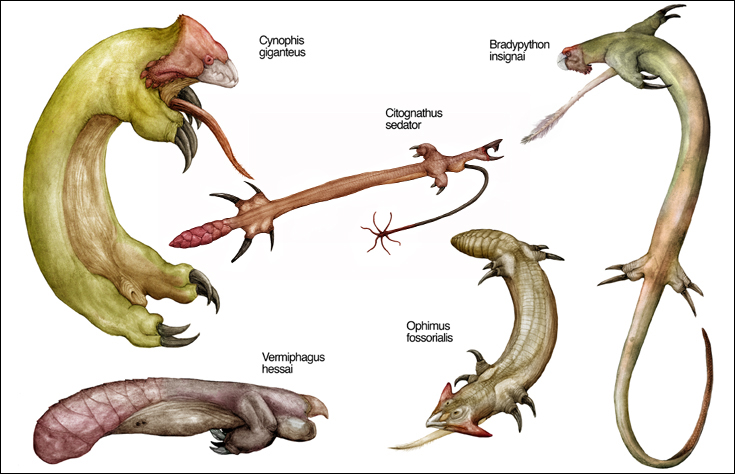Haplobrachids
This is a peculiar group of land animals that are united by the lack of their upper arms and legs. While the comparisons with the organs of Earth-based vertebrates are not exactly accurate, Haplobrachids have the equivalents of hands and feet sticking straight out from their shoulder and hip joints. Surprisingly, this hasn’t stopped them from being wildly successful in numerous sprogland, forest-floor or even arboreal habitats. Haplobrachids are very diverse as small-sized predators and herbivores in these environments and they have some especially large bodied species as well.
Haplobrachids are thought to be closely related to Lophophids and the problematic Sprogophidian clades, and these three groups are loosely united under the clade Panophidia.

Species: Vermiphagus hessai
Common Name: None.
Size: Around 20-25 centimeters long.
Habitat: Two isolated populations live on the isolated forest patches in Pansavannah.
Blind, deaf and almost legless, this unassuming creature belongs in a sister group to all other Haplobrachids. At first looking like a Chasmostome, a further examination of Vermiphagus’ second head and limb structure reveals that it indeed is a Haplobrachid, and the similarities between the two groups are the results of convergent evolution.
Unlike most other burrowers of Snaiad, Vermiphagus really lives underground instead of the surrounding layers of Sprog. It burrows through the rich soil of the forest floor, feeding on whatever it bumps into. Although Vermiphagus hessai has a very limited distribution, related species of Vermiphage Haplobrachids live everywhere in the main landmasses of Snaiad.

Species: Ophimus fossorialis
Common Names: Ofimus, Ratsnake, Chirky.
Size: 12-15 centimeters long.
Habitat: All of Isterna above the Ankyranian desert and Oroland, found mostly in the undergrowth.
Thanks to their high breeding rate, small size and omnivorous diet, Ophimus and related Ophimyids can be found all over Snaiad in a variety of different environments. These creatures skitter along the undergrowth with their unique claw-crawling locomotion and nest together in communal burrows. The species pictured here, O. fossorialis, is notable for its brightly colored cheek flanges; extensions of the first-head mouth that give it a larger storage area for food when foraging and space for a large litter of babies during the breeding season. They feed on anything they can find, be it Picozoans, Trikes, fruit, seeds, sprog-stalks or even the spongy fibers of sprog itself. In return, they provide food for many species of small predators. As a defense some Ophimyids, including O. fossorialis, have developed a mildly venomous bite of their first heads. Found only in the males, this venom is actually derived from their semen and is not harmful to human beings.
Some species of Ophimus (O. domesticus, O melanocephalus) have proved easy to keep and breed in captivity, and are well on their way to domestication. “Fancy” varieties with special colors and lengthened cheek flanges are widely available in pet stores in the large cities.

Species: Citognathus sedator
Common Name: Pitsnake, Headsnake, Hookjaw.
Size: Up to 120 centimeters long.
Habitat: Interior plains and sprogland in Vesterna. Does not occur close to the sea.
The plains of the Western continent are dotted with burrows of Citognathid Haplobrachids such as this; underground carnivores that lure their prey with specialized, scented lures. The lure of Citognathus sedator has specialized to mimic the ubiquitous spider-seastar invertebrates (Trikes) that many small animals feed on. Other species have differently shaped lures that mimic the prey items of different would-be predators. C. sedator is the largest known species, easily growing over a meter long. Starting out life as small, worm-like burrowers, they gradually replace active hunting with a more sedentary luring behavior as they mature. While a well-positioned Citognath may not need to leave its burrow for more than a year, they are still capable of abandoning the nest and hunting their own prey if they go hungry for a long time.
Like the closely related Ophimyids, members of this group subdue their prey with venom that is deadly to local animals, but has hallucinatory side-effects on humans. (Unlike the Ophimyids, both sexes have venom in the Citognathids.) Teenagers from the cities of Savannah and Link sometimes engage in “snake-riding,” deliberately inducing the Citognaths to bite in order to get a buzz. Overdoses are known to be fatal.

Species: Bradypython insignai
Common Names: Slothsnake, Slothworm.
Size: Up to 4-5 meters long, usually smaller.
Habitat: The Azonic jungle, on the western tip of Vesterna.
Not all Haplobrachids are small ground scurriers. In the vast expense of jungle in the Azonic region of Vesterna, a group of Haplobrachids have grown larger than many other species in their lineage. The large, sluggish Slothsnakes are more often heard than seen, with their stereo screams echoing across the impenetrable chaos of the jungle. These calls serve to stake out the individual Slothsnakes’ grazing territories and also attract mates. Slothsnakes feed almost exclusively on vegetation and the fruits of the green and red plants abundant across their range. They move rather slowly from tree to tree, usually spending a few days on each gigantic plant to eat the best portions it has to offer. Although they look defenseless their cryptic body shape, secretive habits and finally, their sharp claws make sure that few predators in the jungle dare to bother them.
There are more than ten known species of Slothsnakes living on Snaiad, four of them in the Azonic jungle. It is certain that more await discovery in the jungles, forests and the pinnacle ranges of Vesterna. The species pictured here, B. insignai, is the largest one known, although even larger “Megasnakes” are reported time to time by visiting explorers.

Species: Cynophis giganteus
Common Names: Garden of Eden Serpent, Drop-snake.
Size: Up to 2.5 meters long.
Habitat: The Azonic Jungle, also present on the Vesternian Pinnacle Range and surrounding forests.
A predatory counterpart to the calm and peaceful Slothsnakes, the Cynophidians are arboreal carnivores that developed independently from ancestral Haplobrachid stock. The diverse and species-rich forests, pinnacle ranges and jungles of Vesterna are home to an incredible variety of Spinostome climbers, Jos, Slothsnakes and other herbivores, not to mention countless invertebrates. Over time, carnivorous relatives of the Ophimyids seem to have taken to the trees after them and developed into the Cynophidians. Like the Ophimyids, some Cynophidians have sperm-borne poisons but the largest species, like Cynophis giganteus pictured here, kill their prey solely through the brute force of their claws and vise-like jaws on their first heads. Because of their wait-and-pounce lifestyle, Cynophidians have secondarily tuned down the efficiency of their metabolisms, remaining torpid and sluggish until they encounter potential prey, which gets captured in a sudden spasm of frenzied activity.
C. giganteus also employs an infamous predatory strategy called “dropping” to capture large prey on the forest floor. As suggested by its name, this behavior involves pouncing onto the prey animal from a low-lying branch, usually killing it through the force of the drop alone. However, this is a very risky strategy that leaves C. giganteus vulnerable to other predators or even physical injury. One eyewitness account reports the demise of an unfortunate individual that attempted to jump on a passing Azonic Lophophid (Erion pentalophus,) but accidentally broke its own backbone upon hitting the ground the wrong way!
Copyright laws protect all intellectual property associated with Snaiad.
All artwork, concepts and names associated with this project belong to C. M. Kosemen, unless otherwise stated.
